The Korea Cruise Train ‘HAERANG': A train trip across four regions in three days
[ Seoul – Suncheon]
On the first day, departing Seoul Station in the morning, the Haerang train drove five hours to Suncheon, Jeollanam-do (South Jeolla Province). A Suncheon guide who was waiting for the Haerang travelers welcomed the group and began to tell stories related to the region. There are several things that symbolize Suncheon: its symbolic flower is the royal azalea, its fruit is the persimmon and its bird is the hooded crane.
“Hooded cranes are a symbol of longevity as well as fidelity, with their sole devotion to their partner. If one dies, the other one takes its life, too,” explained the guide.
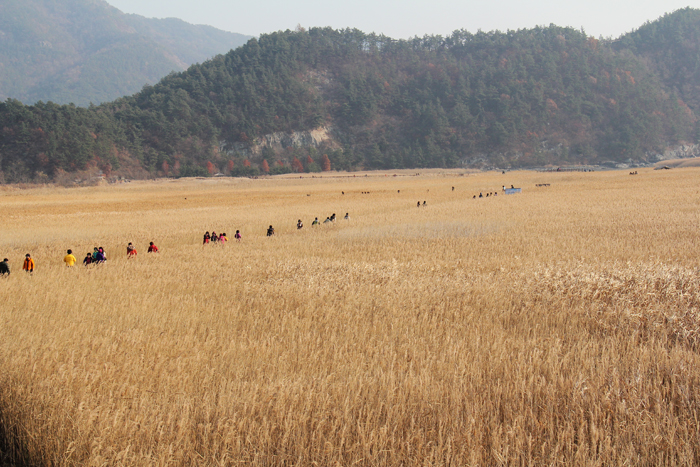
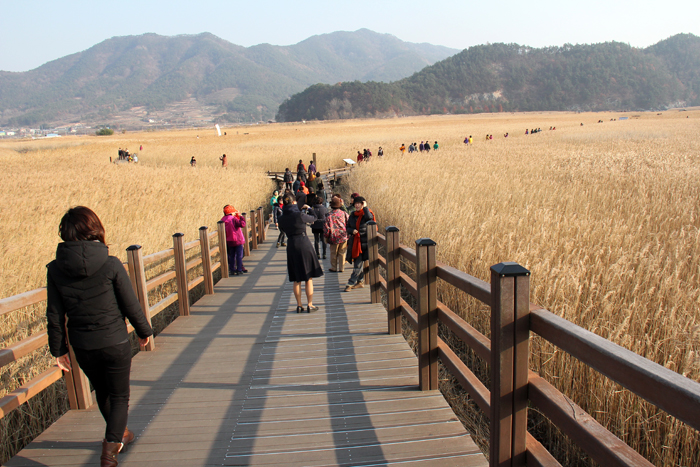
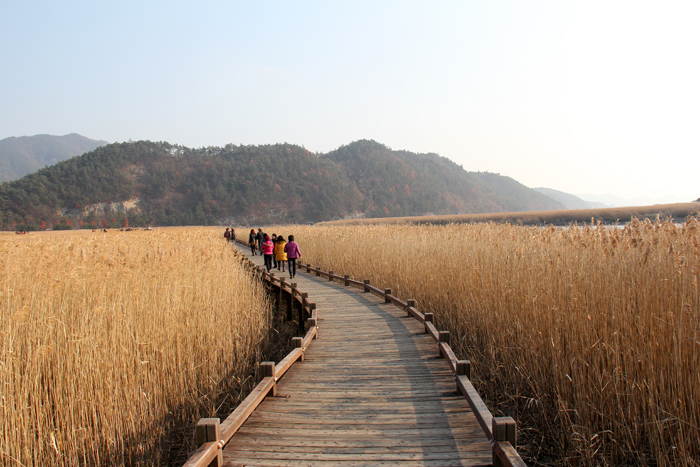
People are busy taking in the beautiful scenery unfolding along the walking paths in the Suncheon Bay Ecological Park, surrounded by mudflats and reeds.
The first stop was a restaurant that offers Suncheon’s delicacy: ggomak, or cockles, a type of small, edible saltwater clam. A bowl of boiled ggomak was served with rice, seasonings and a larger bowl where all the ingredients can be mixed together. People rolled up their sleeves and got involved in the shelling of the tasty bivalve. One of the passengers, who hailed from the Suncheon region, volunteered to help the others unfamiliar with the shelling process.
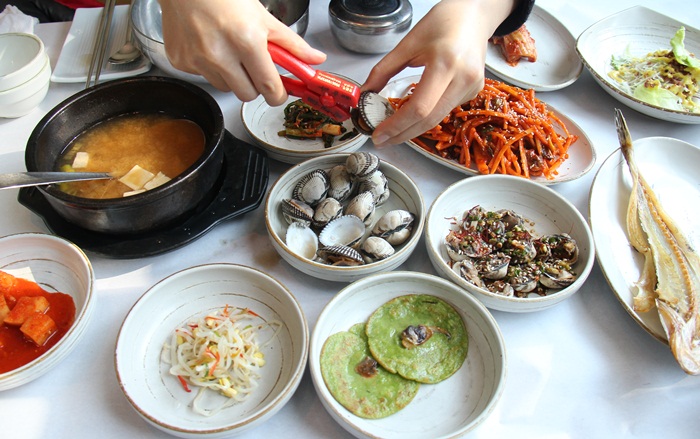
On the lunch table sits a whole variety of ggomak-based dishes, including boiled ggomak, seasoned ggomak and ggomak with a seasoned balloon flower salad.
After lunch, the Haerang group arrived at the Suncheon Bay Ecological Park. Suncheon Bay is one of the world’s top-five best preserved coastal wetlands. It comprises of 5.4 square kilometers of dense giant reeds and endlessly unfolds into 22.6 square kilometers of wide open mudflats. Suncheon offers visitors the rare chance to see a variety of rare birds and other animals that live in and around the mudflats. Thanks to two recent international events– the Yeosu Expo and the Suncheon Bay Garden Expo– that have been hosted in this region, Suncheon has become one of the most popular tourist destinations in Korea.
Walking along the trail surrounded by giant reeds can be a perfect romantic date. The Haerang travelers enjoyed a fresh getaway to nature.
After a little while, the group gathered in the ecological recreation center to sample some more regional delicacies: cereal lattes, reed root tea, soft persimmons and fresh Suncheon eggs. With the taste of “nature,” we already felt healthier.
Suncheon and its neighboring regions have a vibrant rice farming culture. In order to store the rice that was grown in the nearby fields, the ancient residents of Suncheon decided to build the Nakaneupseong, a fortress village. The ancient fortress is the next stop on the Haerang itinerary.
The village comprises of rustic thatch-roofed houses clustered in a 220,000 square meter area. It was originally built with earthen walls in around 1397 to protect the town from invaders, but in the 1400s it was re-constructed with stone and slightly expanded.
The Naksaneupseong is one of Korea’s three representative fortress villages along with the Gochangeupseong in Jeollabuk-do (North Jeolla Province) and the Haemieupseong in Chungcheongnam-do (South Chungcheong Province). Suncheon’s village is well-known for its well-preserved structure as well as for its associated traditions. Around 100 households still continue to live there. Thanks to the Cultural Properties Protection Law, the residents receive a specific subsidy which includes scholarships for the children.
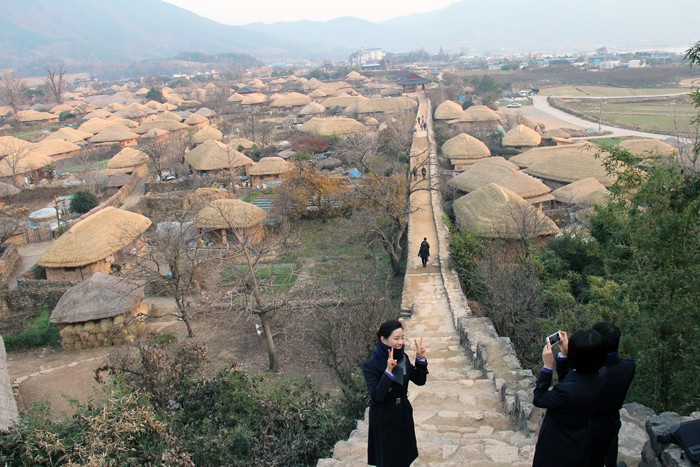
The Nakaneupseong is a large cluster of rustic thatch-roofed houses covering some 220,000 square meters.
“Nak-An” is a Korean phrase meaning “being pleasant and comfortable.” There are East and West Gates at each end, to the left and right, and government offices are located above and the houses of the common people below. It is assumed that there is active communication between the government and the people. In recent years, the site has been popular for filming dramas and movies. Last year, actor Lee Byung-hun stayed here for two days to film “Masquerade.” The drama series “Daejanggeum” was also filmed here, including the waterwheel in many of its shots.


Traditional thatch-roofed houses are normally cool in the summer and warm in the winter.
[ Suncheon – Daegu]
The Haerang train started at dawn on the second day and arrived at Dongdaegu Station early in the morning. The second day itinerary included Palgongsan Mountain and “Modern Alley,” a neighborhood where both modern and historic traces can be found. The main peak of Palgongsan Mountain, Birobong, reaches 1,192 meters and the ridge line stretches over 20 kilometers into the distance. The east peak and west peak on either side of Birobong create an awe-inspiring view.
On the slopes of the mountain are several temples and shrines. Among them is Donghwasa Temple, the largest of the mountain’s ancient temples. The name of the temple means that the paulownia trees around it bloom even during the winter.
Three other must-visit spots are the Daeungjeon Hall, where a statue of the Buddha is enshrined, the Geuknakjeon, with its statue of the Amitabha Buddha, and the Yaksadaebul tower, built to pray for the reunification of the divided Korean Peninsula.
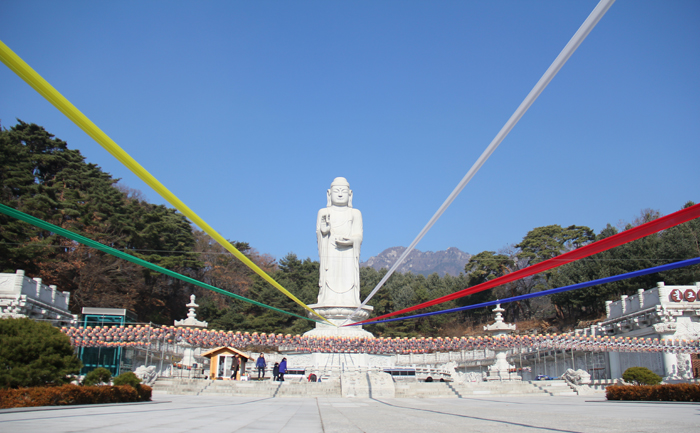
The 30-meter Yaksadaebul tower is located in Donghwasa Temple at Palgongsan Mountain.
In the afternoon, the group of train travelers visited Daegu’s “Modern Alley” to get a glimpse of the modern history of Korea. The first stop was the Jeil Church, the first Christian church in Gyeongsangbuk-do. In earlier times, this Gothic cathedral was where foreign missionaries offered medical care and educational support.
Nearby are two beautiful gardens and adjacent houses. Constructed between 1906 and 1910, the red brick two-storied buildings were used by foreign missionaries who came to Korea to spread Christianity. The buildings are now used as modern medical museums. A variety of items are on display, including medical needles, anesthesia syringes and other surgical instruments, giving visitors a glimpse of Daegu’s past 100 years of education and medical care.
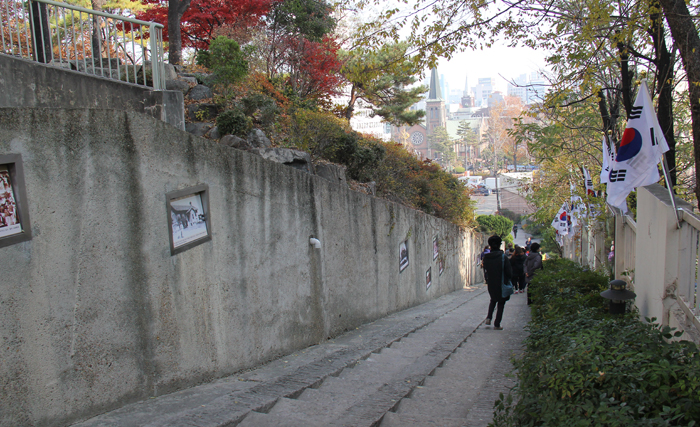
On both sides of the Cheongna Hill hang photographs of the the March First Independence Movement.
The group was led along a small sidewalk to the Cheongna Hill. The path here is the very site that inspired the lyrics of the popular song “Dongmu Saenggak,” or “Thinking about My Friend.” The 90-stair path is known as the March 1st Independence Movement Road. In 1919, students fighting for independence fled up these stairs while escaping from the Japanese army. Pictures from the time are on display along either side of the staircase.

Daegu’s Gyesandong Catholic Church is the only church from the 1900s remaining in the city.
There is a regional specialty one should taste at least once while in Daegu: dongin-dong galbijjim, or braised beef ribs and kimchi in a hot pot. The group of travelers hit the dongin-dong galbijjim alley in central Daegu to sample the spicy and sweet dish. It was a real “rice robber,” so called by many of the visitors. After quickly finishing up their bowls of rice, the group headed for the next destination, Gyeongju.
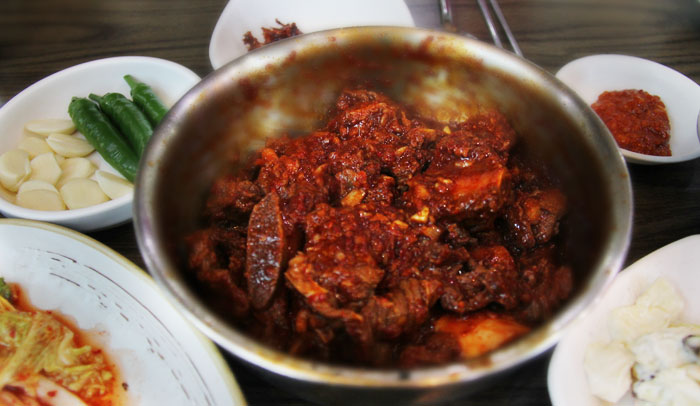
It is delicious to eat the meat on its own, but mixing in the rice with the seasoning gives an even better culinary experience.
[Daegu – Gyeongju]
After zipping along the rails for about one hour, the Haerang train arrived in Gyeongju, the ancient capital of the Silla Kingdom (57 B.C.– A.D. 935). There, the passengers were bussed to one of the must-visit sites of the city: Bulguksa Temple. According to many believers, the temple was designed to emulate the Buddha’s life, as described in the Avataṃsaka Sutra, or Flower Garland Sutra, Hwaeom Gyeong in Korean.
According to the sutra, one should first cross over the “water” and the “clouds” to get to the Buddha’s world, both of which were recreated in the Cheongwoon and Baekwoon bridges at the entrance to Bulguksa Temple. The two bridges boast an aesthetic beauty and solid engineering, designed to even withstand earthquakes.

Bulguksa Temple in Gyeongju
The curious group of Haerang passengers, fully engrossed in the guide’s explanation, nodded in a show of understanding. “I’ve been here three or four times with my grandson to help him learn more about history. But this is the first time I actually hear this interesting and detailed story about how the temple was constructed and about our ancestors’ wisdom embedded in it,” said 60-or-so-year-old Park Myung-sook who was accompanied by her husband during the trip.
[Gyeongju – Jeongdongjin]
In the early dawn on the last day of the trip, the Haerang train stopped at Jeongdongjin Railway Station in Gangneung, Gangwon-do (Gangwon Province).
The station is known as the closest train station in the world to the sea. In front of the station lies the beautiful, picturesque ocean. Jeongdongjin is also well known for the fact that the days of the year when one can see the sunrise there can be counted on one hand. Luckily, this group of Haerang passengers got the rare opportunity to see the sun rise over the horizon.
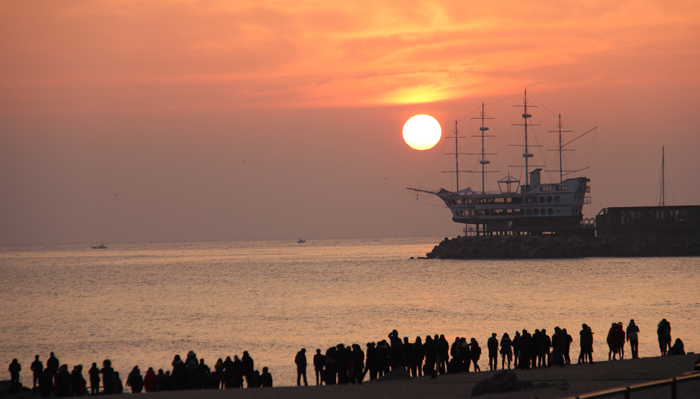
Afterward, the train ran for around 50 minutes and stopped at Seungbu Station in Bonghwa-gun, Gyeongsangbuk-do (North Gyeongsang Province). The station is regarded as one of the most isolated locations in the country. It used to be nothing but a rural flag stop until the 1990s, but now with the many tourist trains, it has become one of the most heavily visited tourist sites in the region.
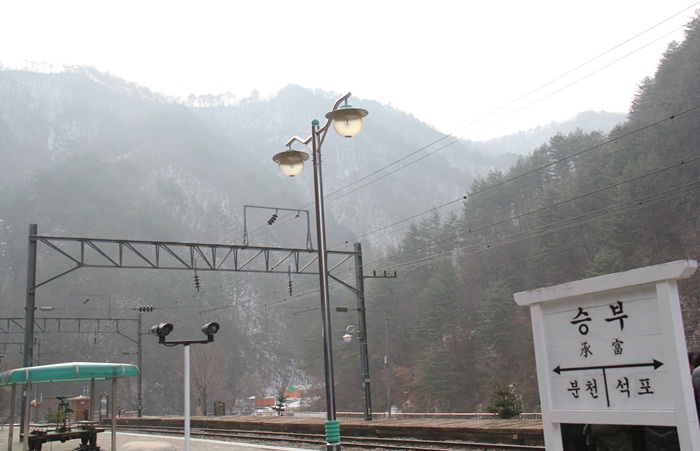
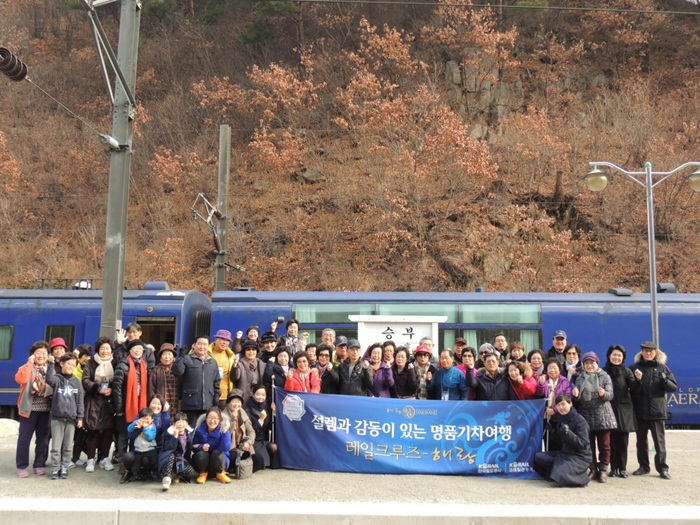
Seungbu Station is one of the most isolated locations in Korea. Surrounded by beautiful mountains, the station exudes great tranquility and peace early in the morning.
After a 30-minute layover, the train started on its way again and reached its final destination, Danyang Railyway Station in Chungcheongbuk-do (North Chungcheong Province). The Haerang group was wowed by three rocky points that jut out of the water near the station, the Dodamsambong. They gazed in awe at the three outcrops, each of which naturally forms a different shape, as their reflections shimmered on the water. A small boat drifting leisurely on the water augmented the serene atmosphere.
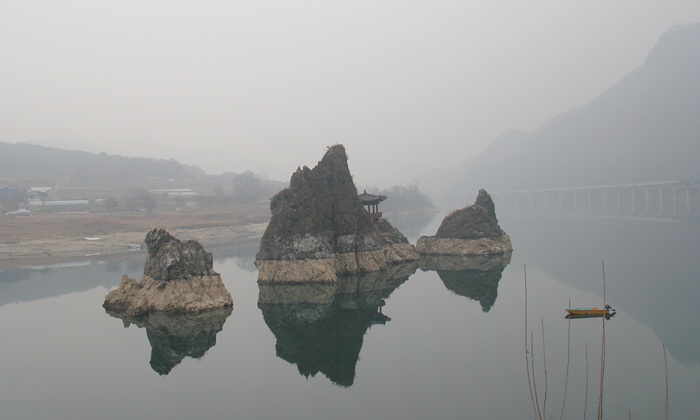
The Dodamsambong rock formation near Danyang Railway Station.
With that awe-inspiring sight forming the last leg of the trip, the Haerang circuit, spanning from Gyeongsang-do and Jeolla-do all the way to Gangwon-do and Chungcheong-do, came to an end.
Though they didn’t want to, the passengers had to get back on the train to Seoul, saying, “We look forward to our next Haerang trip.”
* Interview with Haerang passengers
1. An interview with Eun Chun-ki and Lee Young-bun who have been married for 45 years.
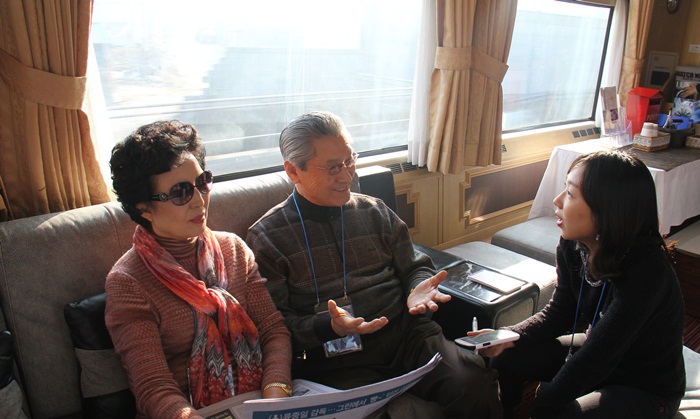
Q1. How did you first hear about Korail’s Haerang service?
A: While on a KTX train to Daegu, I stumbled across an ad for this wonderful train. When I got home, I looked it up on the Internet and realized it would be a great trip. To celebrate our 45th wedding anniversary and my wife’s 75th birthday, we treated ourselves to this Haerang trip.
Up until now, we normally traveled by car. But as we’ve gotten older and older, we find it not as easy to take a trip outside the country or to drive somewhere domestically. We think the Haerang train is the best option for us. We just hop on the train and it takes us to see, hear and eat many new things in a comfortable manner all across the nation.
Q2. How do you feel about this trip?
A: We are fully enjoying this winter Haerang trip. Next time, we’d love to take this trip in the summer. We know that there are some differences in route between the winter and the summer. It would also be great in the summer. We would like to take one of the one-night-two-days weekend trips. While traveling on this train to many corners of the country, we have come across many things that, to our surprise, have changed quite a lot. They are all reminiscent of our good old days.
2. An interview with Lee Heung-pyo who is traveling with his parents.

Q1. How do you feel about this trip?
A: I’ve come here with my parents who are marking their 50th wedding anniversary this year. My parents are enjoying this Haerang train trip. I gave it to them in honor of their anniversary. It was a bit uncomfortable for them to sleep on a rattling train, but it is fine because other things make up for that inconvenience.
Q2. Would you take a Haerang trip again?
A: Sure. We’ve already said that we’ll make sure to come again with my whole family, including my children, in the near future. It has been an amazing experience. We are staying in a family room where we share a bunk bed, with me taking the top. Sleeping on a train is kind of unique and “romantic.” We’ve built another family memory here.
Q3. How about the service?
A: We really love it when we can sample all the regional specialties. All the meals are healthy and my parents have loved all of them. The performances by the Haerang crew really add to the experience. We passengers all mingle together and quickly become friends. My parents, too, have made friends here.
3. An interview with Kim Sook-nyun and Kim Ok-boon who have been friends for over 50 years.
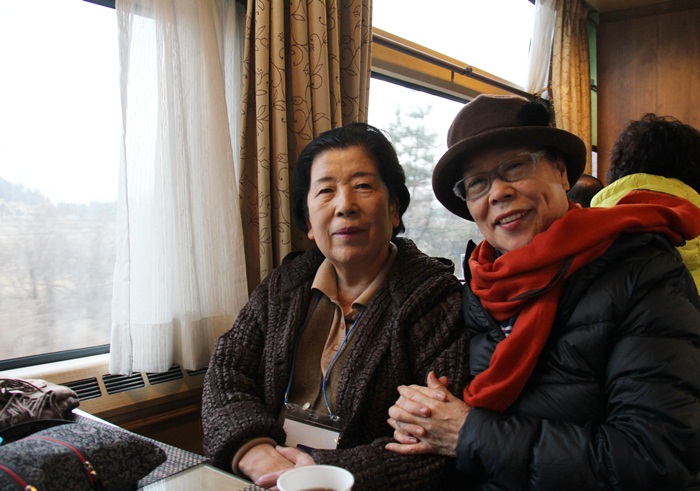
Q1. What made you take a Haerang train vacation?
A: We’ve been friends for over 50 years. We’ve so far traveled together in more than 40 countries all around the world. We’ve also taken so many trips across Korea. But this is the first time to travel on a train all day and all night. It is such a unique and exciting experience.
Q2. What has impressed you two the most during this trip?
A: First of all, we really like the facilities, be it the toilet or the bed. They are all comfortable and clean. We also love the various events that go on inside the train.
We loved it from the moment we hopped on the train. We were so excited. Three days into this trip, and it has never let us down.
We’d like to express our appreciation for the Haerang staff, too, for their friendly service. They are always smiling, at any time of day or night. They attend to the passengers like they’re their own family. Thanks to them, this trip has been great fun and really comfortable.
By Lee Seung-ah, Sohn JiAe
Korea.net Staff writers
slee27@korea.kr

This is a excellent read personally. Must consent that you are one of the coolest doodlekit I ever saw. Appreciate your posting this useful information. This was exactly what I was on looking for. I’ll come back to this blog for sure!
This is a great site post, im thrilled I came across that. Ill return to their office down the observe to check out other posts which